If one dimension of a cube is multiplied by a factor \(\frac{1}{2}\), the volume of the cube \(\ldots\)
7.4 Multiplying a dimension by a constant factor
|
Previous
7.3 Right pyramids, right cones and spheres
|
Next
7.5 Summary
|
7.4 Multiplying a dimension by a constant factor (EMBJ4)
When one or more of the dimensions of a prism or cylinder is multiplied by a constant, the surface area and volume will change. The new surface area and volume can be calculated by using the formulae from the preceding section.
It is important to see a relationship between the change in dimensions and the resulting change in surface area and volume. These relationships make it simpler to calculate the new volume or surface area of an object when its dimensions are scaled up or down.
Consider a rectangular prism of dimensions \(l\), \(b\) and \(h\). Below we multiply one, two and three of its dimensions by a constant factor of \(\text{5}\) and calculate the new volume and surface area.
|
Dimensions |
Volume |
Surface |
|
Original dimensions 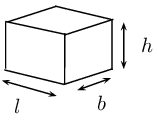
|
\(\begin{aligned} V &= l \times b \times h \\ & =lbh \end{aligned}\) | \(\begin{aligned} A & =2\left[\left(l\times h\right)+\left(l\times b\right)+\left(b\times h\right)\right]\\ & =2\left(lh+lb+bh\right) \end{aligned}\) |
|
Multiply one dimension by \(\text{5}\) 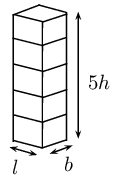
|
\(\begin{aligned} {V}_{1}&= l\times b\times 5h \\ &= 5\left(lbh\right) \\ &= 5V \end{aligned}\) | \(\begin{aligned} A_1 &= 2\left[\left(l\times 5h\right)+\left(l\times b\right)+\left(b\times 5h\right)\right] \\ &= 2\left(5lh+lb+5bh\right) \end{aligned}\) |
|
Multiply two dimensions by \(\text{5}\) 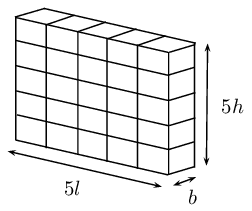
|
\(\begin{aligned} V &= 5l \times b \times 5h \\ &= 5 \cdot 5 (lbh) \\ &= 5^2 V \end{aligned}\) | \(\begin{aligned} & A_2 \\ =& 2\left[ (5l\times 5h) + (5l\times b) + (b\times 5h) \right] \\ =& 2\times 5 (5lh + lb + bh) \end{aligned}\) |
|
Multiply all three dimensions by \(\text{5}\) 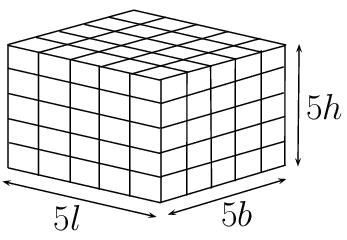
|
\(\begin{aligned} V &= 5l \times 5b \times 5h \\ &= 5^3 (lbh) \\ &= 5^3 V \end{aligned}\) | \(\begin{aligned} & A_3 \\ =& 2\left[ (5l\times 5h) + (5l\times 5b) + (5b\times 5h) \right] \\ =& 2\times (5^2lh + 5^2lb + 5^2bh) \\ =& 5^2 \times 2 (lh + lb + bh) \\ =& 5^2 A \end{aligned}\) |
|
Multiply all three dimensions by \(k\) 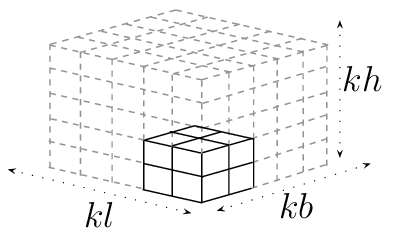
|
\(\begin{aligned} V &= kl \times kb \times kh \\ &= k^3 (lbh) \\ &= k^3 V \end{aligned}\) | \(\begin{aligned} & A_k \\ =& 2\left[ (kl\times kh) + (kl\times kb) + (kb\times kh) \right] \\ =& 2\times (k^2lh + k^2lb + k^2bh) \\ =& k^2 \times 2 (lh + lb + bh) \\ =& k^2 A \end{aligned}\) |
Worked example 5: The effects of \(k\)
The Nash family wants to build a television room onto their house. The dad draws up the plans for the new square room of length \(k\) metres. The mum looks at the plans and decides that the area of the room needs to be doubled. To achieve this:
- the mum suggests doubling the length of the sides of the room
- the dad recommends adding \(\text{2}\) \(\text{m}\) to the length of the sides
- the daughter suggests multiplying the length of the sides by a factor of \(\sqrt{2}\)
- the son suggests doubling only the width of the room
Who's suggestion will double the area of the square room? Show all calculations.
Draw a sketch
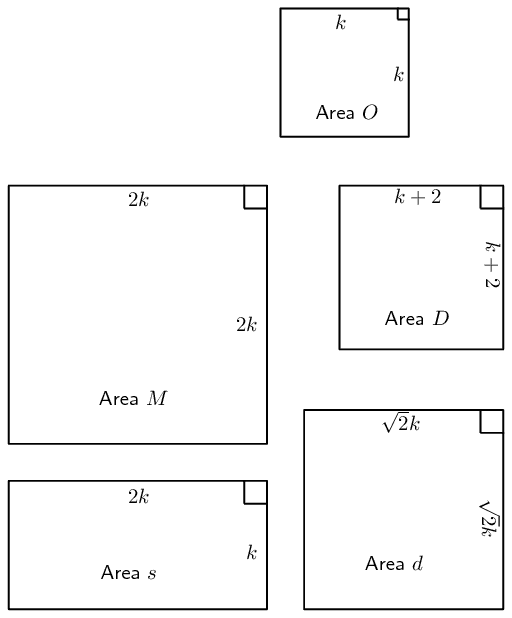
Calculate and compare
First calculate the area of the square room in the original plan: \begin{align*} \text{Area } O &= \text{length} \times \text{length} \\ &= k^2 \end{align*} Therefore, double the area of the room would be \(2k^2\).
Consider the mum's suggestion of doubling the length of the sides of the room: \begin{align*} \text{Area } M &= \text{length} \times \text{length} \\ &= 2k \times 2k \\ &= 4k^2 \end{align*} This area would be \(\text{4}\) times the original area.
The dad suggests adding \(\text{2}\) \(\text{m}\) to the length of the sides of the room: \begin{align*} \text{Area } D &= \text{length} \times \text{length} \\ &= (k+2) \times (k+2) \\ &= k^2 + 4k + 2 \\ &\ne 2k^2 \end{align*} This is not double the original area.
The daughter suggests multiplying the length of the sides by a factor of \(\sqrt{2}\): \begin{align*} \text{Area } d &= \text{length} \times \text{length} \\ &= \sqrt{2}k \times \sqrt{2}k \\ &= 2k^2 \end{align*} The daughter's suggestion would double the area of the room. Practically, the length of the room could be multiplied by \(\sqrt{2} \approx \text{1,41}\) which would given an area of \(\text{1,96}\) \(\text{m$^{2}$}\).
The son suggests doubling only the width of the room: \begin{align*} \text{Area } s &= \text{length} \times \text{length} \\ &= 2k \times k \\ &= 2k^2 \end{align*} The son's suggestion would double the area of the room, however the room would no longer be a square.
Write the final answer
The daughter's suggestion of multiplying the length of the sides of the room by a factor of \(\sqrt{2}\) would keep the shape of the room a square and would double the area of the room.
The effects of \(k\)
Complete the following sentences:
If two dimensions of a cube are multiplied by a factor \(\text{7}\), the volume of the cube \(\ldots\)
If three dimensions of a cube are multiplied by a factor \(\text{3}\), then:
If each side of a cube is halved, then:
The municipality intends building a swimming pool of volume \(W^3\) cubic metres. However, they realise that it will be very expensive to fill the pool with water, so they decide to make the pool smaller.
The dimensions of the pool are reduced so that the volume of the pool decreases by a factor of \(\text{0,8}\). Determine the new dimensions of the pool in terms of \(W\) (remember that the pool must be a cube).
Each side should now be slightly more than \(\frac{9}{10}\) of original length .
|
Previous
7.3 Right pyramids, right cones and spheres
|
Table of Contents |
Next
7.5 Summary
|
